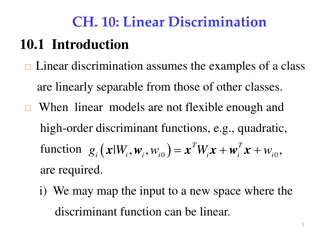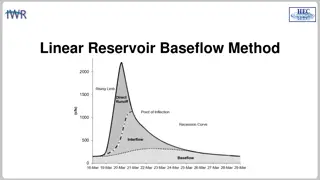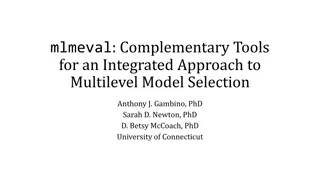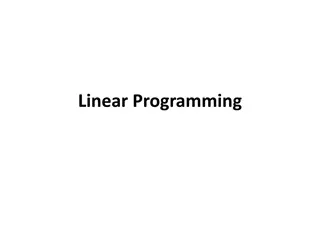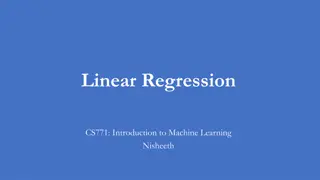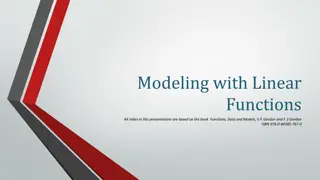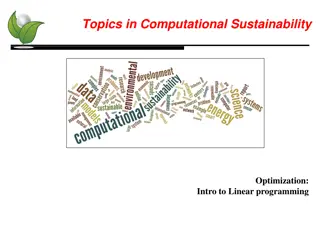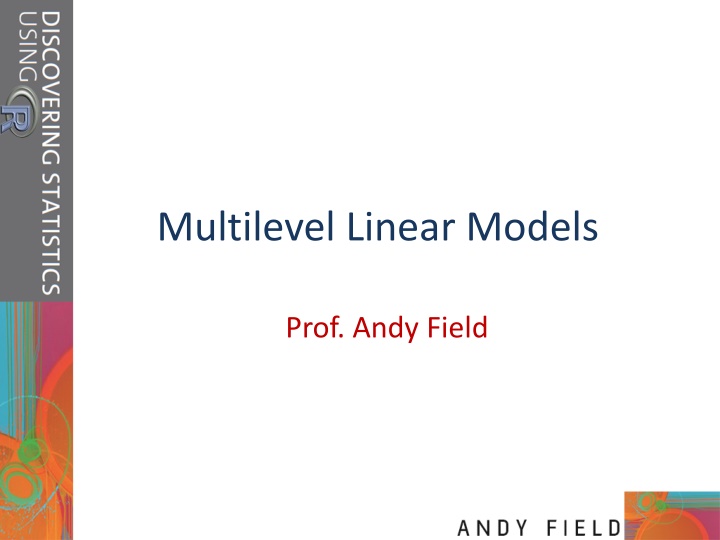
Multilevel Linear Models in Data Analysis
Explore the world of multilevel linear models with Prof. Andy Field as you delve into hierarchical data structures, intraclass correlation, benefits of fixed and random coefficients, and conducting example analyses. Learn about the significance of two- and three-level hierarchies, regression slopes, and handling missing data in multilevel models.
Download Presentation

Please find below an Image/Link to download the presentation.
The content on the website is provided AS IS for your information and personal use only. It may not be sold, licensed, or shared on other websites without obtaining consent from the author. If you encounter any issues during the download, it is possible that the publisher has removed the file from their server.
You are allowed to download the files provided on this website for personal or commercial use, subject to the condition that they are used lawfully. All files are the property of their respective owners.
The content on the website is provided AS IS for your information and personal use only. It may not be sold, licensed, or shared on other websites without obtaining consent from the author.
E N D
Presentation Transcript
Multilevel Linear Models Prof. Andy Field
Aims Multilevel models Hierarchical data Intraclass correlation Benefits Fixed and random coefficients Comparing models Covariance structures Centring Conducting and Interpreting an example analysis Growth models Types of growth model Conducting and interpreting an example analysis Slide 2
Hierarchical Data Data structures are often hierarchical Examples: Children nested within classrooms Data points nested within people Employees nested within organizations Patients nested within hospitals Patients nested within doctors nested within clinics Slide 3
A Two-Level Hierarchy Level Class 1 Class 2 Class 3 Class 4 Class 5 Class 6 Class n 2 ... Child 1 Child 9 Child 13 Child 20 Child 28 Child 33 Child a Child 2 Child 10 Child 14 Child 21 Child 29 Child 34 Child b Child 3 Child 11 Child 15 Child 22 Child 30 Child 35 Child c Child 4 Child 12 Child 16 Child 23 Child 31 Child 36 Child d 1 Child 5 Child 17 Child 24 Child 32 Child 37 Child e Child 6 Child 18 Child 25 Child 38 Child 7 Child 19 Child 26 Child 8 Child 27
Intraclass Correlation (ICC) Data from the same context will be more similar than data from different contexts E.g. children in the same class will perform more similarly than children from different classes Lack of independence Creates problems in ANOVA/regression (correlated residuals) The ICC measures the variability within contexts E.g. the variability within classrooms
Benefits of Multilevel Models Homogeneity of regression slopes Model the variability in regression slopes Assumption of independence You can model the relationships between cases (Regression for repeated observations) Missing data MLMs can cope with missing data
An Example: Cosmetic Surgery Post_QoL This is a measure of quality of life after the cosmetic surgery. Base_QoL Quality of life before the surgery. Surgery A dummy variable that specifies whether the person has undergone cosmetic surgery (1) or whether they are on the waiting list (0). Clinic Which of 10 clinics the person attended to have their surgery. Age The person s age in years. BDI Natural levels of depression measured using the Beck Depression Inventory (BDI). Reason This dummy variable specifies whether the person had/is waiting to have surgery purely to change their appearance (0), or because of a physical reason (1). Gender Whether the person was a man (1) or a woman (0).
Fixed vs. Random Coefficients Intercepts and slopes can be fixed or random In OLS regression they are fixed Fixed coefficients Intercepts/slopes are assumed to be the same across different contexts Random coefficients Intercepts/slopes are allowed to vary across different contexts
How to Represent These Models Fixed intercepts and slopes Random intercepts and fixed slopes Fixed intercepts and random slopes Random intercepts and random slopes
The Surgery Example Fixed intercepts and slopes Random intercepts and random slopes
Comparing Models Models should be built up gradually Start with fixed coefficients Change one aspect of the model and compare to the previous with the change in the 2LL Assessing fit AIC BIC
Covariance Structures Variance components Random effects are independent with similar variances Diagonal Random effects are independent with different variances AR(1) Random effects are related with data points closer in time being more similar than those distant in time Variances of random effects are similar Unstructured Covariances and variances of random effects are unpredictable
Centring Grand mean centring Take each score and subtract from it the mean of all scores (for that variable) Group mean centring Take each score and subtract from it the mean of scores from the same group (for that variable) Effects of centring in multilevel models The effects are complicated Models using centred variables tend to be more stable It can help with problems of multicollinearity
Ascertaining Whether There Is Variation over Your Contexts First we need to fit a baseline model in which we include only the intercept: interceptOnly <-gls(Post_QoL ~ 1, data = surgeryData, method = "ML") summary(interceptOnly) Next, we fit a model that allows intercepts to vary over contexts: randomInterceptOnly <-lme(Post_QoL ~ 1, data = surgeryData, random = ~1|Clinic, method = "ML") summary(randomInterceptOnly) Finally, we compare these two models to see whether the fit has improved as a result of allowing intercepts to vary. If it has, we jump on the runaway train to multilevel insanity; if it has not, we do a little dance of joy into the loving arms of a simpler life: anova(interceptOnly, randomInterceptOnly)
Add the variable Surgery as a predictor To add the variable Surgery as a predictor, execute: randomInterceptSurgery <-lme(Post_QoL ~ Surgery, data = surgeryData, random = ~1|Clinic, method = "ML") summary(randomInterceptSurgery)
Add Next Predictor to the Model Add quality of life after surgery, with intercepts varying across clinics: randomInterceptSurgeryQoL <-lme(Post_QoL ~ Surgery + Base_QoL, data = surgeryData, random = ~1|Clinic, method = "ML") summary(randomInterceptSurgeryQoL)
Compare Models We can have a look at how the fit of the models has improved using the anova() function that we used before; the following will compare all three models that we have so far fitted): anova(randomInterceptOnly, randomInterceptSurgery, randomInterceptSurgeryQoL)
Introducing Random Slopes addRandomSlope<-lme(Post_QoL ~ Surgery + Base_QoL, data = surgeryData, random = ~Surgery|Clinic, method = "ML") summary(addRandomSlope) anova(randomInterceptSurgeryQoL, addRandomSlope)
Summary of the Model Containing Both Random Slopes and Intercepts
Adding an Interaction Term to the Model addReason<-lme(Post_QoL ~ Surgery + Base_QoL + Reason, data = surgeryData, random = ~Surgery|Clinic, method = "ML") finalModel<-lme(Post_QoL ~ Surgery + Base_QoL + Reason + Surgery:Reason, data = surgeryData, random = ~Surgery|Clinic, method = "ML") We need to see whether adding these new terms has improved the fit of the model, and again we can simply use the anova() function: anova(addRandomSlope, addReason, finalModel)
Follow-Up Analysis Surgery to change appearance: cosmeticSubset<-surgeryData$Reason==0 cosmeticModel<-lme(Post_QoL ~ Surgery + Base_QoL, data = surgeryData, random = ~Surgery|Clinic, subset= cosmeticSubset, method = "ML ) summary(cosmeticModel) Surgery for a physical problem: physicalSubset<- surgeryData$Reason==1 physicalModel<-lme(Post_QoL ~ Surgery + Base_QoL, data = surgeryData, random = ~Surgery|Clinic, subset= physicalSubset, method = "ML") summary(physicalModel)
The Model for Those Who Had Surgery for a Physical Reason
The Model for Those Who Had Cosmetic Surgery
Growth Models Growth models look at the rate of change of a variable over time Depression over 8 weeks of treatment Back pain over 10 weeks of physiotherapy Profits over months of the year Radioactive decay
An Example: The `Honeymoon Period Speed dating event After a speed dating event data were collected on all people who ended up in a relationship with the person that they met on the speed dating night. None of the people measured were in the same relationship. Satisfaction_Baseline A 10-point scale (0 = completely dissatisfied, 10 = completely satisfied) Satisfaction_6_Months Life satisfaction at 6 months (0 10) Satisfaction_12_Months Life satisfaction at 12 months (0 10) Satisfaction_18_Months Life satisfaction at 18 months (0 10) Gender
Restructuring Data Data entry for multilevel models Need the variable Time to be represented by a single column. We refer to this format as the long format. As such we need to restructure the data. But, in repeated measures designs we re used to entering data so that instances of the outcome appear in different columns.
Setting up the Basic Model First, we fit a baseline model in which we include only the intercept: intercept <-gls(Life_Satisfaction ~ 1, data = restructuredData, method = "ML", na.action = na.exclude) Next, we need to fit the same model, but this time allowing the intercepts to vary across contexts (in this case we want them to vary across people): randomIntercept <-lme(Life_Satisfaction ~ 1, data = restructuredData, random = ~1|Person, method = "ML", na.action = na.exclude, control = list(opt="optim"))
Adding in Time as a Fixed Effect We can quickly update the previous model (randomIntercept) to include Time as a predictor by executing: timeRI<-update(randomIntercept, .~. + Time)
Introducing Random Slopes We use the update() function to create a new model (called timeRS) which is identical to the previous model (timeRI) but updates the random part of the model to be random = ~Time|Person: timeRS<-update(timeRI, random = ~Time|Person)
Modelling the Covariance Structure We can add a covariance structure to the model using the update() function to create a new model (called ARModel) which is identical to the previous model (timeRS) but adds in a first-order autoregressive covariance structure: ARModel<-update(timeRS, correlation = corAR1(0, form = ~Time|Person))
Comparing Models We can compare all five models by executing: anova(intercept, randomIntercept, timeRI, timeRS, ARModel)
Final Model We can take a quick look at the final model, and the confidence intervals for the parameter estimates within it by using: summary(ARModel); intervals(ARModel)
To Sum Up Data can be hierarchical and this hierarchical structure can be important. Most of the tests that you learn simply ignore the hierarchy. Hierarchical models are just a fancy regression in which you can estimate the variability in the slopes and intercepts within entities. Slopes and intercepts can be random variables (allowed to vary) rather than fixed (assumed to be equal in different situations). Start with a model that ignores the hierarchy and then add in random intercepts and slopes to see if they improve the fit of the model. Growth curves model trends in the data over time These trends can also have variable intercepts and slopes. Slide 49


